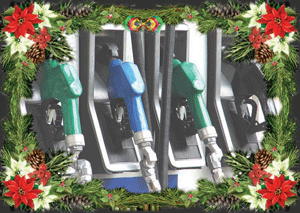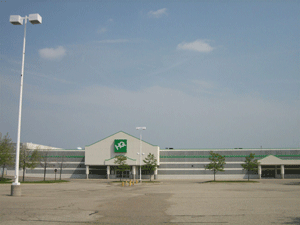Thanks for the pre-paid gas card, Santa
U.S. consumers may not be feeling particularly jolly heading into the holiday shopping season this year, with more than one-third of consumers across all income levels expecting to spend less, according to research from New York researcher The Nielsen Company. Only 6 percent expect to spend more, and 50 percent of consumers surveyed expect to spend the same amount as last year during the holiday shopping season, historically defined as Thanksgiving week through the last week of December. It seems all shoppers want for Christmas is value. Of those consumers who report they’ll spend about the same, about half report they will spend the same amount this year in grocery stores, supercenters and mass merchandisers. The holiday season may prove to be a bigger challenge for department and electronic stores, with almost one-third of consumers expecting to spend less in these stores this year. Convenience and gas retailers may come out ahead this year, with 12 percent of consumers expecting to spend more in these locations, likely related to a rise in pre-paid gas cards as gifts this holiday season.
It seems all shoppers want for Christmas is value. Of those consumers who report they’ll spend about the same, about half report they will spend the same amount this year in grocery stores, supercenters and mass merchandisers. The holiday season may prove to be a bigger challenge for department and electronic stores, with almost one-third of consumers expecting to spend less in these stores this year. Convenience and gas retailers may come out ahead this year, with 12 percent of consumers expecting to spend more in these locations, likely related to a rise in pre-paid gas cards as gifts this holiday season.
Of those consumers surveyed who entertain at home, 29 percent plan to spend less this holiday season, including 26 percent of high-income consumers. For those entertaining away from home, 33 percent expect to spend less, including 31 percent of affluent consumers.
Nielsen forecasts 4.7 percent growth in dollar sales, or $98 billion, across grocery stores, drug stores, mass merchandisers and convenience stores, for the holiday shopping season. The growth forecast, slightly higher than last year’s 4.5 percent gain, is in large part due to higher commodity prices. Nielsen projects unit sales, however, to be flat or down 0.8 percent versus a year ago.
Necessities, rather than novelties and luxuries, are expected to drive holiday sales this year. Toiletries, baby-care products, food items and gift cards for groceries, gasoline, telephone and car maintenance are expected to see strong sales. Practical, cold-weather apparel (i.e., socks, fleece jackets and undergarments) and household goods (i.e., cookbooks, bed and bath linens and kitchen supplies) are also expected to sell well.
With retail vacancies climbing, developers must reinvent the mall
The $55 million makeover that brought a movie theater and two stories of upscale shops and restaurants to Rosedale Center two years ago has turned out to be a well-timed hedge for the Roseville, Minn., regional mall, according to Susan Feyder’s September 8, 2008, article “Malls that risked makeovers better off,” in the StarTribune.
Store closings and reduced expansion plans by retailers are taking a toll on regional malls in the Twin Cities and elsewhere. The International Council of Shopping Centers released a report that said it expects 144,000 stores to close in 2008. That’s up 7 percent from 2007 - the largest increase in 14 years, the New York-based trade group said. 
The vacancy rate at Twin Cities-area regional malls, which had started falling in 2004, has edged up recently to about 6.3 percent, according to NorthMarq, a Bloomington, Minn., real estate services firm. Higher vacancies can have financial consequences that go beyond the loss of rent from a departing tenant. It may cost more for a mall to attract new tenants to a center that’s perceived to be struggling, said Tricia Pitchford, vice president, retail brokerage services, NorthMarq.
So-called club stores like Costco and Sam’s Club have begun showing up in vacant anchor space in regional malls on the West Coast, and it’s possible that trend could eventually begin cropping up in other areas of the country, including the Midwest. “There used to be the idea that you didn’t see a shopping cart at a regional mall, but that’s starting to change,” said Richard Grones, founder of Cambridge Commercial Realty, an Edina, Minn., firm that specializes in the retail market. “People are becoming less resistant to the notion of shopping at a mall for perishables.”
Two Twin Cities malls, Southdale and Brookdale, are examples of malls that put off redevelopment and now find themselves struggling. Paula Mueller, general manager at Northtown Mall in Blaine, Minn., said malls must keep reinventing themselves to remain viable. “We can’t predict or control what a retailer’s plans might be, but you’re in a better position if you keep moving ahead on improvements,” she said.
In the last couple of years Northtown has attracted a Best Buy, Burlington Coat Factory and a Steve & Barry’s to space vacated by Kohl’s and Homeplace. In August, an LA Fitness sports club opened in a spot once occupied by Montgomery Ward. In September 2008, a Herberger’s department store opened at Northtown, formerly a Mervyn’s location. Mueller said the latest changes will boost the mall’s occupancy to 99 percent.
The Northtown Steve & Barry’s recently survived a round of closings announced by the new owners of the chain. Mueller said that might not have been the case if Northtown had forgone redevelopment.
More online shoppers picking in-store pickup
This holiday season, the desire to avoid the mad dashes through the aisles and the high shipping prices that accompany shopping online are driving more and more consumers to opt for online ordering and in-store pickup, and likewise driving retailers to improve their online ordering and in-store pickup processes. According to research from Chicago research company the e-tailing group, a primary appeal is free shipping to the store, which 96 percent of all merchants surveyed now offer, as compared to 92 percent last year.
Efficiencies within the store, like the pickup location more frequently being at the customer service area and more related in-store signage, are further evidence of the feature’s integration within the brick-and-mortar environment. The overall wait time is also improving for store pickup - down to an average of 2.58 minutes versus 3.21 minutes last year and 3.64 the year prior. Products were ready and waiting when the customer arrived at the store 94 percent of the time, up from 83 percent in 2007.
